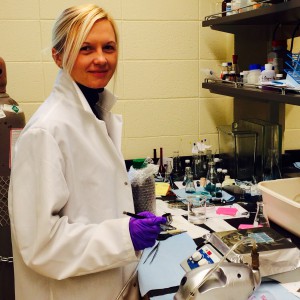
Anastasiia Iefanova, 2011-2013, Ukraine, conducting experimental procedures on the fabrication of semitransparent dye-sensitized solar cells at South Dakota State University
My Fulbright experience started with a Pre-academic Language Program at the University of Arkansas. There, I had an unforgettable experience interacting with students from different countries who became my friends while studying English with me. Meeting people from different parts of the world was one of the highlights of my Fulbright experience as it broadened my world view and helped me to better understand people from different cultural backgrounds. Living with a host family also improved my understanding of American culture as well as my English skills. My host family was very kind and helped me with everything. At the end of my Pre-academic Language Program, my English skills had improved exponentially. These experiences helped me to successfully begin my academic program at South Dakota State University and become more independent while living in the United States.
My master’s program in electrical engineering at South Dakota State University was initially very challenging. Everything was different from my previous school: the academics, how things were organized, and the teaching style. After a couple of months, things became more familiar, and I started to focus more on my research by working with Dr. Mahdi Farrokh Baroughi and his group.
My research is focused on making thin film transparent dye-sensitized solar cells for use on windows, and Dr. Mahdi Farrokh Baroughi’s research projects aligned well with my interests. Transparent solar cells can potentially work as absorptive tinted films for windows to reduce glare and bright light, and also convert unwanted non-transmitted light into electricity. I spent a lot of time in the laboratory learning how to fabricate dye-sensitized solar cells and to use equipment in order to characterize fabricated devices. In order to find ways in which I could contribute to the existing research on photovoltaics, I read many papers. I realized that the main issue in the fabrication of transparent dye-sensitized solar cells is a Pt counter electrode. After reading these papers, my ideas were concentrated on how I might make solar cells transparent and efficient at the same time. I tried many different fabrication techniques, but unfortunately, they were not successful. I ended up a little frustrated. I realized, however, that failure happens to everyone involved in research, so I kept trying. Finally, I developed a new technique for the fabrication of Pt counter electrode. I did not expect that this fabrication method would provide great results when incorporated into dye-sensitized solar cells, but they did! I was very excited. Soon after I completed my research, I successfully defended my master’s thesis at South Dakota State University.
During the two years of my Fulbright grant, my life changed significantly. I became stronger both personally and academically. Interacting with my academic colleagues helped me to gain professional experience. People in South Dakota are extremely friendly and nice, and always interested in meeting people from other countries. I made many friends who helped me to handle all of the difficulties I encountered. Even though my family was so far away, I had a big circle of very good friends who supported me. Having a Fulbright community helped me to accomplish my academic goals. I am so grateful to Fulbright for giving me this opportunity to make big changes in my life and hopefully others through my research.

No Comments